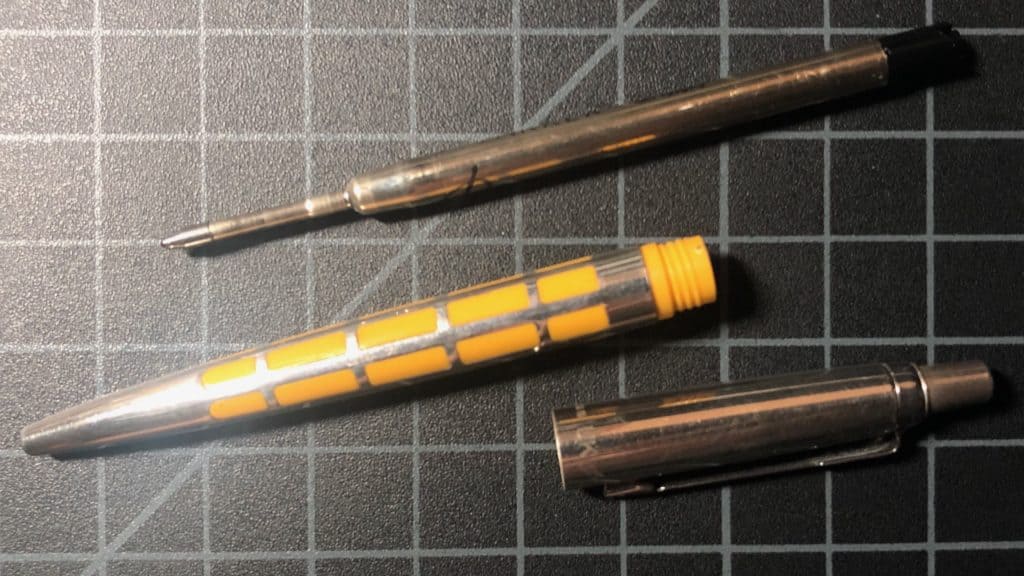When buying a pen you will encounter many of the same words each type you buy. The number one thing you should be looking out fo– so you know what to expect from the pen — is the type of ink. Two popular and often confused types are ballpoint and gel ink.
So what’s the difference between ballpoint and gel pens?
Don’t miss our Ink Type Guide to learn about all types of pen ink.
Ballpoint Ink Compared to Gel Ink
When it comes to comparing these two types of ink, the most important thing to note is that ballpoint ink is oil-based and gel ink is water-based.
Ballpoint ink is very thick and only the barest amount needs to be applied in order for it to write on paper, with the ink seeming to sit on the paper as opposed to sinking into it. This is one reason why ballpoint ink seems like it will write on almost any surface — if it can grip the material then the ball will roll and ink will be applied. This is why ballpoint pens will write on glossy magazine covers, on wood, on plastic bags, on leather, and everything in between.
Ballpoint ink can be pressurized so that some ballpoint pens can write upside down, underwater, and in other adverse conditions.
Gel ink is based on water that has been thickened with a proprietary blend of materials. You can read the history of gel pens for all the details, but the larger point is that a gel pen is a type of rollerball that uses gel ink as opposed to a liquid ink. Gel ink won’t write on as many surfaces but the watery ink writes incredibly smoothly
Ballpoint vs. Gel Sizes
Ballpoint ink doesn’t spread on the paper so that you will often see a very large ball that writes near the size of the ball or smaller. Gel ink soaks into the paper and it the spreads to some extent (depending on the paper).
In practice, this means a 1.6 mm ballpoint pen might write a 1.4 mm (measured width) line where a 1.0 mm gel pen might also write a 1.4 mm wide line.
Ballpoint vs. Gel Pen Bodies
Both pen types are sold in a huge variety of sizes, but generally speaking gel pens will be limited by the fact that a much higher volume of gel ink is needed for a given quantity of writing than ballpoint ink. This means gel pens need large, and often wide, refills where ballpoint pen refills can be sold in a huge variety.
This is why you see ballpoint pens in tiny D1 refills, but not gel pens — they would just run down too fast.
Because of the small quantity of ink required and thus the small size of the refills, you see a wide variety of ballpoint pen bodies. Ballpoint ink makes the Lamy Pico and Fisher Space Pen Bullet pen possible.
Ballpoint vs. Gel Refills
Ballpoint and gel refills come on all sorts of sizes, but they generally aren’t interchangeable. Ballpoint ink is thick and is used sparingly while gel ink is watery and is consumed by the pen at a much quicker pace. This means that ballpoint pens use skinny ink reservoirs while gel ones tend to be a good deal larger.

Typical ballpoint refill will be skinny and long, usually made out of plastic. If not in this style then the refill will be a Parker-style or “G2” refill.
Gel refills are usually made of plastic and are long and wide. A common example would be the refill found in a Pilot G2 or Zebra Sarasa.
One area where the two intersect is in the Parker-style refill, which usually contains ballpoint ink but is also sold with gel ink. Parker-style refills with gel ink aren’t that common as a percent of all pens, but they are easy to find if you are looking for them.
Ballpoint vs. Gel Writing
Each of these ink types can vary considerably from one pen to another and from one brand to another, so this will only be a generalization, but it should help nonetheless.
Ballpoint pens tend to write on almost any surface and under almost all conditions. The oil-based ink seems to stick to surfaces better than any other ink, short of a permanent marker. The thick ink feels thick when you are writing with it, as if the movement was slow or you were pushing through something. This “drag” is something many people expect from a pen, but it’s been reduced in recent years as ballpoint inks have advanced.
Gel pens and their watery ink are known for their smoothness. They glide over the paper with easy, but won’t write if the surface isn’t able to absorb the ink. This means gel pens can’t write well on glossy paper or on non-standard surfaces, like wood.
Popular Ballpoint Pens
Popular Gel Pens
Read More: Gel vs Rollerball Pens
